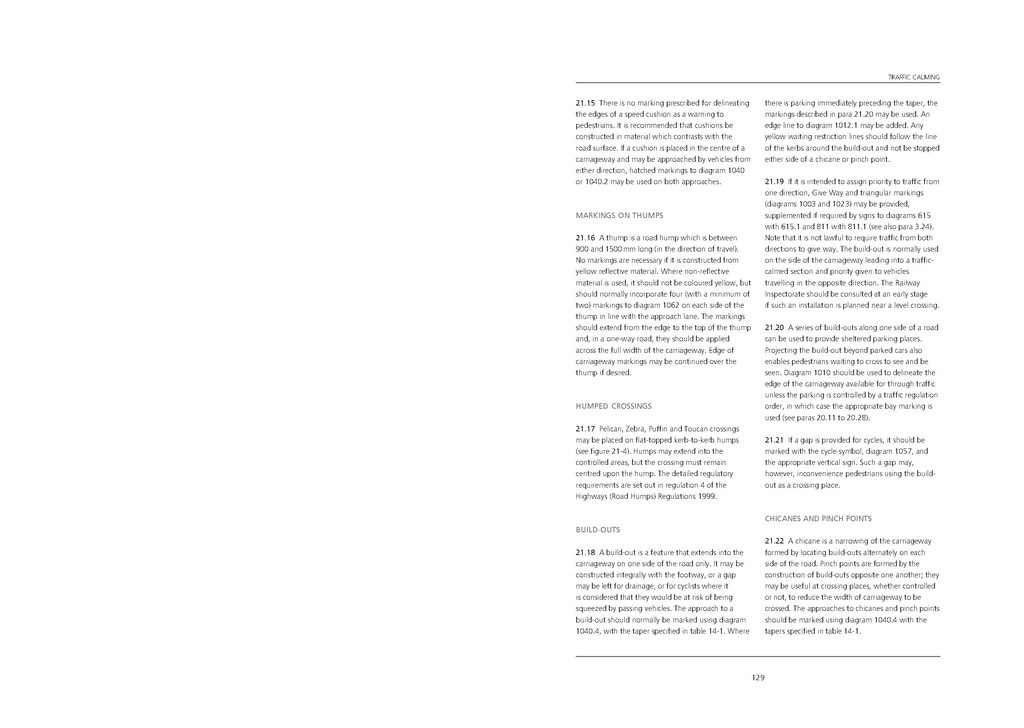21.15 There is no marking prescribed for delineating the edges of a speed cushion as a warning to pedestrians. It is recommended that cushions be constructed in material which contrasts with the road surface. If a cushion is placed in the centre of a carriageway and may be approached by vehicles from either direction, hatched markings to diagram 1040 or 1040.2 may be used on both approaches.
MARKINGS ON THUMPS
21.16 A thump is a road hump which is between 900 and 1500 mm long (in the direction of travel). No markings are necessary if it is constructed from yellow reflective material. Where non-reflective material is used, it should not be coloured yellow, but should normally incorporate four (with a minimum of two) markings to diagram 1062 on each side of the thump in line with the approach lane. The markings should extend from the edge to the top of the thump and, in a one-way road, they should be applied across the full width of the carriageway. Edge of carriageway markings may be continued over the thump if desired.
HUMPED CROSSINGS
21.17 Pelican, Zebra, Puffin and Toucan crossings may be placed on flat-topped kerb-to-kerb humps (see figure 21-4). Humps may extend into the controlled areas, but the crossing must remain centred upon the hump. The detailed regulatory requirements are set out in regulation 4 of the Highways (Road Humps) Regulations 1999.
BUILD-OUTS
21.18 A build-out is a feature that extends into the carriageway on one side of the road only. It may be constructed integrally with the footway, or a gap may be left for drainage, or for cyclists where it is considered that they would be at risk of being squeezed by passing vehicles. The approach to a build-out should normally be marked using diagram 1040.4, with the taper specified in table 14-1. Where there is parking immediately preceding the taper, the markings described in para 21.20 may be used. An edge line to diagram 1012.1 may be added. Any yellow waiting restriction lines should follow the line of the kerbs around the build-out and not be stopped either side of a chicane or pinch point.
21.19 If it is intended to assign priority to traffic from one direction, Give Way and triangular markings (diagrams 1003 and 1023) may be provided, supplemented if required by signs to diagrams 615 with 615.1 and 811 with 811.1 (see also para 3.24). Note that it is not lawful to require traffic from both directions to give way. The build-out is normally used on the side of the carriageway leading into a traffic-calmed section and priority given to vehicles travelling in the opposite direction. The Railway Inspectorate should be consulted at an early stage if such an installation is planned near a level crossing.
21.20 A series of build-outs along one side of a road can be used to provide sheltered parking places. Projecting the build-out beyond parked cars also enables pedestrians waiting to cross to see and be seen. Diagram 1010 should be used to delineate the edge of the carriageway available for through traffic unless the parking is controlled by a traffic regulation order, in which case the appropriate bay marking is used (see paras 20.11 to 20.28).
21.21 If a gap is provided for cycles, it should be marked with the cycle symbol, diagram 1057, and the appropriate vertical sign. Such a gap may, however, inconvenience pedestrians using the build-out as a crossing place.
CHICANES AND PINCH POINTS
21.22 A chicane is a narrowing of the carriageway formed by locating build-outs alternately on each side of the road. Pinch points are formed by the construction of build-outs opposite one another; they may be useful at crossing places, whether controlled or not, to reduce the width of carriageway to be crossed. The approaches to chicanes and pinch points should be marked using diagram 1040.4 with the tapers specified in table 14-1.
129
